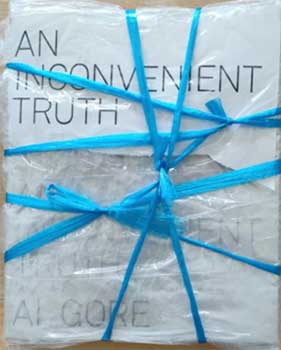
Detail of one of the ‘prepared’ books. Here Al Gore’s An Inconvenient Truth is given a Christo like wrap.
#oldmediahouse oldmediahouse more to come before 1 December 2024.
Old Media House oldmediahouse

Detail of one of the ‘prepared’ books. Here Al Gore’s An Inconvenient Truth is given a Christo like wrap.
#oldmediahouse oldmediahouse more to come before 1 December 2024.
Old Media House oldmediahouse
Tags: kaiparacoastsculpture, kaiparacoastsculpturegardens, oldmediahouse, tewhareaopapaho
The birth of Islam created a new space where non-Arabs and the lower strata of the tribes were included.
The Arabic text closest to the entrance to the first gallery of the Ko rātou, ko tātou | On other-ness, on us-ness exhibition (See details here or go to the blog introducing this exhibition) that was on show at NorthArt, Auckland, reads as “first house” (avvala baytin). Below this was the sentence from the Qur’an:
“Indeed, the first House [of worship] established for humanity was that at Makkah [Bakka] – blessed and a guidance for the worlds.”
The Qur’an, 3:96

Left to Right: Wave (detail), custom-made water tank by Jeff Thomson (link to a discussion of this work); Arabic text above reads: “first house (avvala baytin)”; Vitruvian Angel Man with Spirit Level (2018) by Ursula Christel. Courtesy the artist and Mokopōpaki Acrylic, gesso, printed perspex, metal lugs, graphite, sealant on board (99 x 61cm), plastic spirit level (6 x 61cm);
Gavin Chilcott Pilgrimage to Mecca, 50 x 70 cm. Framed pastel on paper. Courtesy: John Perry.
Ever since the 1980s, when I first started reading about Islam, coming from a Roman Catholic background myself, I was struck by the concept of the qibla because while Rome is important, Catholics around the world, do not face a specific location while in prayer. The significance of this as I viewed it was that the Prophet Muhammad had envisioned a worldwide religion – of all cultures around the world facing the same location, as a daily sign of a shared global focus. Then while engaged in research for this exhibition I discovered that the text from the Qur’an refers to a change of direction, because previously the Prophet’s followers had faced Jerusalem when they prayed which was also the Jewish custom, and now they were to face Mecca (also known as Bakka or Bekka, the name of the area, or Makkah. See 2:144 which speaks of changing the qibla to Mecca).
For me as a Bahai, this brought in the concept of progressive revelation, the idea that all religions are the same religion (with the same God), and the variations are in relation to culture and history. So I saw the change as indicative of the evolution of Islam, even during the time of the Prophet Muhammad. It also explained for me why The Dome of the Rock built in Jerusalem in 691–92 at the order of Umayyad Caliph Abd al-Malik could have been built, although there is no clear record of its initial purpose. At the time, Jerusalem was a holy city for Jews and Christians. This building rivalled the Christian buildings, transforming the best aspects of current Byzantine architecture into a new form. The 1022-23 rebuilt Dome of the Rock has texts on the walls referring to Islamic teachings about Jesus. Today it is one of the oldest extant works of Islamic architecture, protects the rock believed to bear the imprint of the Prophet Muhammad’s foot, and is an icon and influence on Islamic architecture.

Foreground: New Space / Takawaenga, 2020, by Ursula Christel.
Left to Right: Wake, custom-made water tank, by Jeff Thomson; Arabic text reads: “first house”; Vitruvian Angel Man with Spirit Level, 2018, by Ursula Christel. Courtesy the artist and Mokopōpaki; Pilgrimage to Mecca, 1986, by Gavin Chilcott.
Ursula Christel’s floor piece, made for this exhibition, New Space / Takawaenga, is the result of her research inspired by the concept of inclusion and the geometry of the floor plan of the Dome of the Rock. This Islamic holy place stands on a site that is sacred to Jews, Christians and Muslims – three of the Abrahamic religions.

Foreground: New Space / Takawaenga, 2020, by Ursula Christel.
Left to Right: Wake, custom-made silkscreened water tank, by Jeff Thomson; Arabic text “first house” (avvala baytin); Vitruvian Angel Man with Spirit Level by Ursula Christel. Courtesy the artist and Mokopōpaki; Pilgrimage to Mecca by Gavin Chilcott; From the Eros and Psyche series (111), 1966/67, gouache on silk, by Joanna Margaret Paul, Courtesy M Paul;
two untitled corrugated iron sculptures by Jeff Thomson.
Like the Dome of the Rock, Christel’s, New Space / Takawaenga, is based on polygonal structures – of lines and repetitions of forms creating illusory space/s. Christel’s ‘new space’ is conceptualized not only in the multi-layered sight lines heading off at diverse angles across the space of the gallery but the stark checkered tiles also pull the eye to the pivot.

New Space / Takawaenga, 2020, by Ursula Christel. re-purposed wooden table (dia. 118 cm), 4 table legs (H: 46 cm), vinyl flooring, 3 mm acrylic sheets (83 x 83cm), glass chess board (38 x 38cm), ceramic tile (20 x 20cm), composite board (dia. 65cm), jute, LED lights.
The architectural references connect to her other work in the same gallery space, Vitruvian Angel Man with Spirit Level, which also features circles within squares and vice versa.
This painting features a translucent image of her son who was born with Angelman syndrome, inside a circle superimposed over an image of Leonardo’s Vitruvian Man. Leonardo’s ‘ideal man’ is a faded shadow within a larger circle while Christel’s son sits up in a wheelchair with his arms held up and elbows bent outwards, a gesture that I — having met him a few times — recognize as meaning he is happy and excited.
Left to Right: Vitruvian Angel Man with Spirit Level by Ursula Christel;
Pilgrimage to Mecca, 1986, by Gavin Chilcott.
On the wall opposite was Talking Sticks by Carolyn Lye and above another text in Arabic. This read: “Until you have asked permission”

Left to Right: The Prison of Self, 2015, by Sonja van Kerkhoff, 20 cm diameter, photographic print, texts in Persian, Māori and English, and oil-based varnish. Edition of 35. Text is from the Hidden Words by Baha’ullah, founder of the Bahai Faith; Text in Arabic reads: “Until you have asked permission,”; Talking Sticks, Korare stems, acrylic paint – 5 pieces, by Carolyn Lye.

Left to Right: The Prison of Self, by Sonja van Kerkhoff; Talking Sticks by Carolyn Lye; Conference of the Stones, 2013, video with soundscape by Phil Dadson (link to a discussion of this work); Detail of New Space / Takawaenga by Ursula Christel.
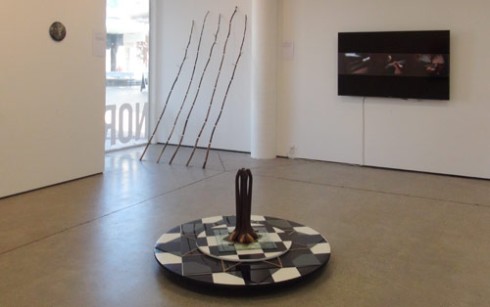
Left to Right: The Prison of Self by Sonja van Kerkhoff; Talking Sticks by Carolyn Lye; New Space / Takawaenga by Ursula Christel; Conference of the Stones by Phil Dadson.
The Māori title of Christel’s floorpiece, ‘Takawaenga’ (mediating/ed space/s), refers to a process. The work can also be read as an upside down table. A table that has been re-conceived in layerings, yet its circular form and central focus, created by the arrangement of the four legs, make it not a table but rather a direction for moving towards. In Sufi thought the lote tree of the outer limit (Sidrat al-Muntaha) marks the direction of all journeys. In choosing a circular table form and turning it over, the artist was inspired by George Dei’s words, “Inclusion is not bringing people into what already exists; it is making a new space, a better space for everyone.” 1

Left to Right: New Space / Takawaenga by Ursula Christel; Conference of the Stones by Phil Dadson; Peace Flight, 2011, giclée digital print by Brenda Liddiard. About her work >>
1. Dei, G.S.N. (2006). Meeting equity fair and square. Keynote address to the Leadership Conference of the Elementary Teachers’ Federation of Ontario, September 28, 2006, Mississauga, Ontario, Canada.
About the 24 artists in the exhibition >>
Carolyn Lye, based near Karetu, Northland, Aotearoa | New Zealand, is a fibre artist who weaves and works in natural materials.
Gavin Chilcott, born in Auckland, Aotearoa | New Zealand, in 1950 and attended Auckland Technical Institute in 1967 followed by three years at Elam, School of Fine Arts, Auckland, from 1968-1970. His first exhibition was at the Barry Lett Gallery in 1976 and since then he has exhibited widely throughout New Zealand and Internationally. He has been a recipient of numerous Arts grants and is represented in all major New Zealand Collections.
Sonja van Kerkhoff, born 1960 in Hawera, Taranaki, Aotearoa | New Zealand, has a diploma in Fine Arts (1980-82, Otago School of Arts), dip Secondary Teaching (1986), Masters equivalent with a double major (1989-93, School of Fine Arts, Maastricht, The Netherlands) and a MSc in Media Technology (2005-8, University of Leiden, The Netherlands). She lives in Kawakawa, Northland, Aotearoa / New Zealand and The Hague, The Netherlands. sonjavank.com
Ursula Christel, born 1961 in Durban, South Africa, is of Celtic/ Germanic descent, immigrated to New Zealand in 1996. She has a BA Degree, majoring in Fine Art and Art History (1979 – 81) and a post grad Diploma in Education (1982). She is an artist, tutor, writer and disability advocate, and worked as a writer, editor and photographer for the Celebrate Art series of educational resources, featuring New Zealand and Australian artists.
Ko rātou, ko tātou | On Other-ness, on us-ness
NorthArt, Northcote, Auckland, Aotearoa | New Zealand
curated by Salama Moata McNamara + Sonja van Kerkhoff
Open now until 31 May 2020
Artists will be at the gallery 12-3pm,
Sat., Sun., and Monday, 12-3, 23-25th May

Left to Right: Wave, custom-made water tank by Jeff Thomson
Vitruvian Angel Man with Spirit Level by Ursula Christel. Courtesy the artist and Mokopōpaki
Pilgrimage to Mecca by Gavin Chilcott.
From the Eros and Psyche series (111) by Joanna Margaret Paul
Two untitled corrugated iron sculptures by Jeff Thomson
(foreground) New Space / Takawaenga (2020) re-purposed wooden table (dia. 118cm), 4 table legs (H: 46cm), vinyl flooring, 3mm acrylic sheets (83 x 83cm), glass chess board (38 x 38cm), ceramic tile (20 x 20cm), composite board (dia. 65cm), jute, LED lights by Ursula Christel.
New Space / Takawaenga is a conceptual assemblage inspired by geometry and the floor plan of the Dome of the Rock. It refers also to a quote by George Dei (2006) – “Inclusion is not bringing people into what already exists; it is making a new space, a better space for everyone.”
Takawaenga is a process. – Ursula Christel, 2020
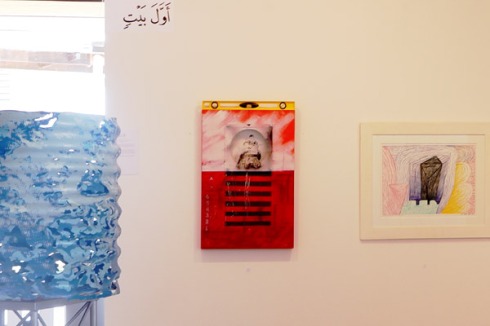
Left to Right: Wave (detail), custom-made water tank by Jeff Thomson
Vitruvian Angel Man with Spirit Level (2018) by Ursula Christel. Courtesy the artist and Mokopōpaki Acrylic, gesso, printed perspex, metal lugs, pencil, sealant on board (99 x 61cm), plastic spirit level
(6 x 61cm). Gavin Chilcott Pilgrimage to Mecca Framed pastel on paper.
Arabic text above reads: “first house (avvala baytin)” A4 text below this begins with:
“Indeed, the first House [of worship] established for humanity was that at Makkah
– blessed and a guidance for the worlds”. The Qur’an, 3:96
This is one of 5 texts in Arabic arranged around the first gallery.
More about these texts and the works in the next blog.
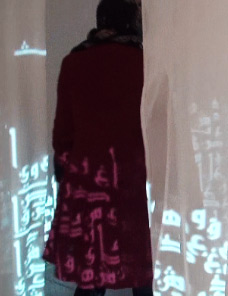
still: “Haykal Al Noor” (Bodies of Light), site specific video installation by Narjis Mirza
with the soundscape, “Pamor” by Jessika Kenney
in this short video on youtube which also shows these works:
“Light District,” framed canvas, LED lighting, by John Mulholland;
“Halg” (Throat) video from the series Sokout/Silence, by Azadeh Emadi;
“Ka aroha” (Love), gouache and ink on paper,
by Salama McNamara & Emma Paton;
“Auckland Flowers 15/03/2019,” dried flowers, soil, compost, brown paper, by Java Bentley;
“Love is Blind,” embossed braille on paper,
by Tash Nikora;
“Fabric of Humanity” cast glass with impressions of a hijab pattern based on the hijab worn by New Zealand Prime Minister Jacinda Ardern in 2019 by Layla Walter;
“Fifty-one” an installation incorporating an assemblage of painted stacked cards and texts from Rumi by Michelle Mayn.
Some photos of the exhibition are here: artsdiary.co.nz
The banana box itself is a migrant entering the country on the back of trade as well as being the ubiquitous storage system. But I am being too serious, because this exhibition oozes with joy and lightheartedness. The images are light or delicate with not a trace of angst and none of the boxes are overly battered. There is an out of the box sense of exploration and play that blurs the lines of “object making, performance, political activism, community organizing, environmentalism and investigative journalism, creating a deeply participatory art” [1] experience. In another sense the box functions as an enabler of alterity (to reference Spivak whose 1997 Documenta lecture made a huge impact on me), a way of exhibiting the photographic in a divergent space – from the inside of the migrant banana box, with whatever baggage it might have that distinguishes it from a gallery wall.
Footnote: Outside the Citadel, Social Practice Art Is Intended to Nurture, New York Times, 2013
“Reconfiguring” by Sarah Kippenberger and Chris Schreuder,
29 March – 27 April 2019,
The Shutter Room, 9 Rust Avenue, Whangārei
Opposite the public library main door
Wed – Fri 12-4pm, Sat 10-2pm
The Shutter Room Facebook page

“See Nothing,” monoprint on paper by Roger Morris, “Bird of Prey” video by Sanne Maes, “Outer mantel 3” + “Outer mantel 4” (and each side of the open wall) by Yair Callender, “Trope” (in the third gallery beyond) by Raewyn Turner and ceramic sculpture by Jess Paraone, “Tomorrow will never be the same” interactive projection by Jian Yiwei and Sonja van Kerkhoff,
2 video loops by Pieterje van Splunter.

“Vaat” (Washing Up) 2014, stop motion animation, 7 minutes, 11 seconds, and “Cleaning the Air,” 2014, video, 43 seconds by Pieterje van Splunter, The Hague.
“Cleaning the Air” is a film of a sculpture by Pietertje which rotated diverse household items.
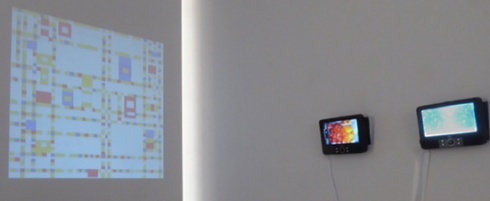
“Tomorrow will never be the same” interactive work by Jian Yiwei and Sonja van Kerkhoff, 2 video loops by Pieterje van Splunter.
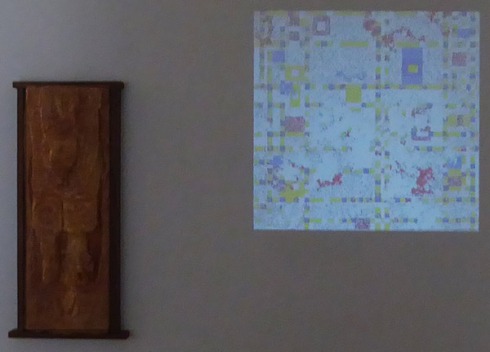
“Outer Mantel 4” by Yair Callender, “Tomorrow will never be the same” interactive work by Jian Yiwei and Sonja van Kerkhoff
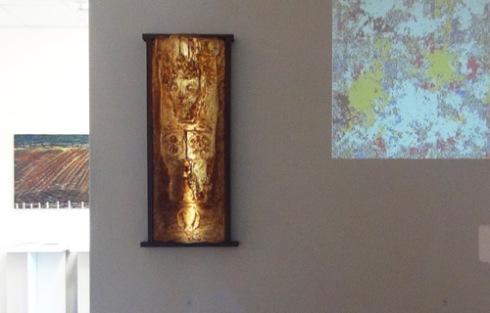
Detail of “Trope” (in the third gallery beyond) by Raewyn Turner and ceramic sculpture by Jess Paraone, “Outer Mantel 4” by Yair Callender, “Tomorrow will never be the same” interactive work by Jian Yiwei and Sonja van Kerkhoff
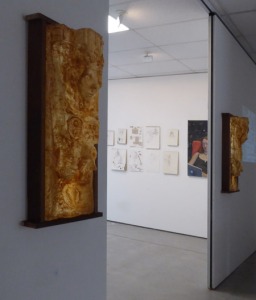
“Outer mantel 3 + 4” (on each side of the open wall), Layers of latex, LED lighting + recycled NZ pine, by Yair Callender. The wooden support was built to instructions given by Yair which included reusing old wood. Detail in the back gallery of drawings by Marianne Muggeridge.
He works in concrete, plaster, clay and wood and his main focus is on making public sculpture.
Often his sculpture has some performative social element that involves the local community.
His major themes are cultural expressions and art in society in relation to playing with the idea of beauty in the ugly. The two larger pieces, layers of resin which are back-lit, were made for this exhibition.
These four pieces are playful interpretations of diverse religious symbols (Catholic gargoyles, Asian temples, the Kabbalah tree, etc) found on the exterior of buildings. He has made skins which are lit from within as a metaphor for our human condition – the beautiful seen through the rough and raw. Who could say art is ever ugly?

“Bird of Prey” video by Sanne Maes, latex light boxes by Yair Callender
Back gallery: “Your Honour” + “Eva was hier” (Eve was here) by Sonja van Kerkhoff, “Pandora’s Box” suspended panels by Alexis Hunter.
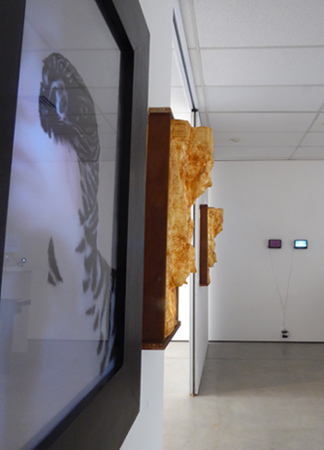
Detail: “Bird of Prey” video by Sanne Maes, latex light boxes by Yair Callender. Two videos by Pieterje van Splunter
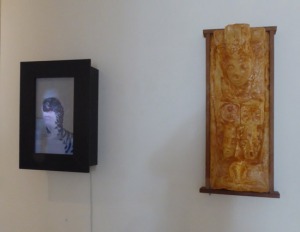
“Bird of Prey” video, HD, loop 0’25” photocopy on transparent paper. 21″ LCD tv inside custom-made frame, 61 x 40, Edition of 3. “Outer mantel 3” latex, LED lighting + recycled NZ pine, by Yair Callender.
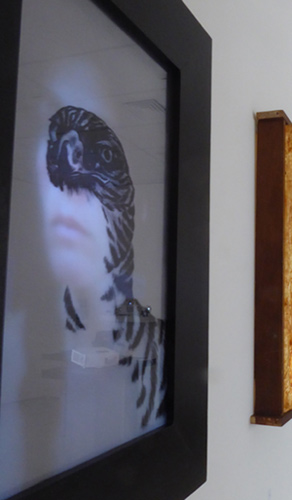
Detail: “Bird of Prey” video by Sanne Maes.
The woman slowly turns her head away and then when she looks ahead her eyes match that of the hawk.

Videos by Channa Boon (The Hague), by Jonathan Reus + Sissel Marie Tonn (The Hague), and by Raewyn Turner and Brian Harris (Auckland). Four etchings by Virgina Guy (Hikurangi, Northland).
Side wall: Monoprint by Roger Morris (Taranaki), video by Sanne Maes (The Hague) and back lit latex relief by Yair Callender.
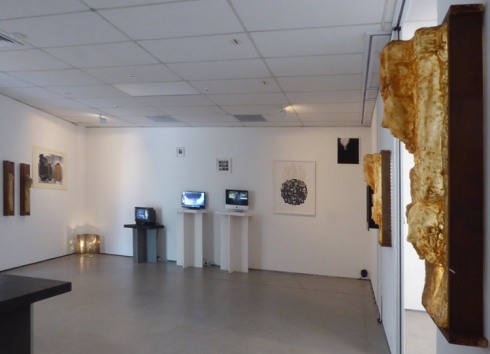
The latex boxes by Yair Callender on the left light up when approached. Monoprint by Roger Morris. Suspended sheet metal and lamp by Sonja van Kerkhoff. Videos by Channa Boon, by Jonathan Reus + Sissel Marie Tonn, and by Raewyn Turner and Brian Harris. Four etchings by Virgina Guy.
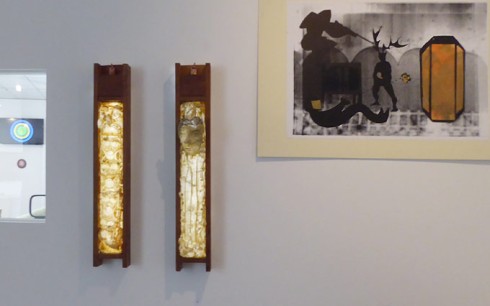
“Plastic Play,” video by Pietertje van Splunter
Middle Gallery: “Outer Mantel 1 + 2” responsive light latex light boxes by Yair Callender. “Road to JerUSAlem,” monoprint on paper by Roger Morris.
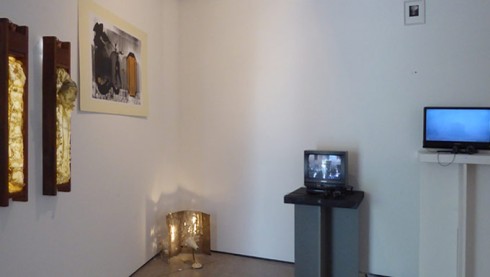
Responsive light latex light boxes by Yair Callender. Monoprint on paper by Roger Morris. “Fain would they put out God’s light,” cut out text sheet steel, nylon and lamp by Sonja van Kerkhoff. “Et in Arcadia ego” 29 min video by Channa Boon, “Sensory Cartographies,” 7 min video by Jonathan Reus + Sissel Marie Tonn. “Finding Flight,” photo intaglio with gold leaf by Virginia Guy.

Above: two etchings by Virginia Guy. “Et in Arcadia ego” 29 min video by Channa Boon. “Sensory Cartographies,” 7 min video by Jonathan Reus + Sissel Marie Tonn. “Fallible,” 3 min video by Raewyn Turner and Brian Harris.
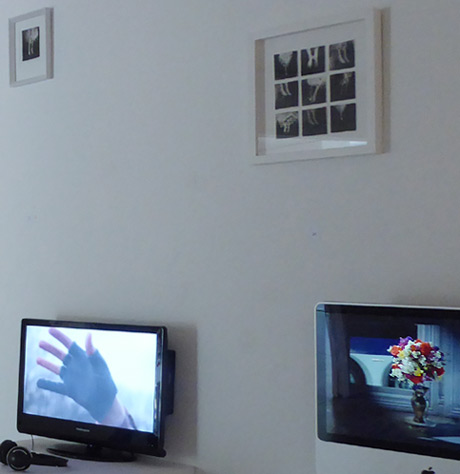
Above: “Finding Flight,” photo intaglio with gold leaf. Edition 1/1, 23 x 28 cm
“Finding Flight,” photo Intaglio with gold leaf. Edition 1/1, 33 x 33 cm by Virginia Guy.
“Sensory Cartographies,” 7 min video by Jonathan Reus + Sissel Marie Tonn.
“Fallible,” 3 min video by Raewyn Turner and Brian Harris. Unscented flowers rotate above a vase which holds a sensor and the data from the sensor is turned into piano notes.
More: raewynturner.com/projects
Raewyn Turner & Brian Harris combine art, engineering, science research and their skills developed over years of practice in theatre, the film industry, robotics, interactive software, video, olfactory, art installations and performances. They engage simple elements with engineering to create experiential art, utilising everyday objects reinterpreted with robotics, electronics and microprocessors.
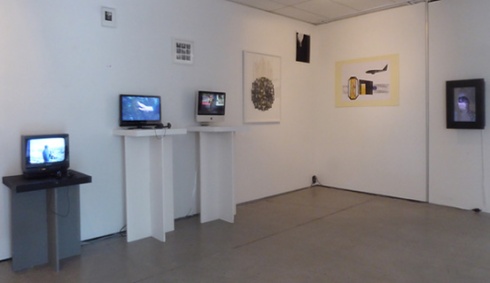
Wall on right: “See Nothing,” monoprint on paper, 2017 by Roger Morris,
“Bird of Prey” video in custom frame by Sanne Maes.
Back wall: 4 etchings on paper by Virginia Guy.
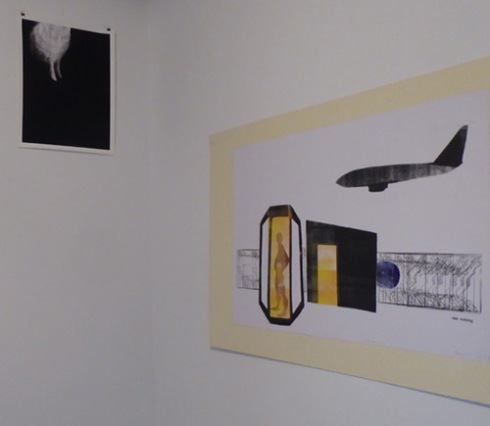
“Finding Flight,” photo intaglio on rag paper. Edition 1/10, 23 x 28 cm. “See Nothing,” monoprint on paper. 2017, by Roger Morris [R E M O].
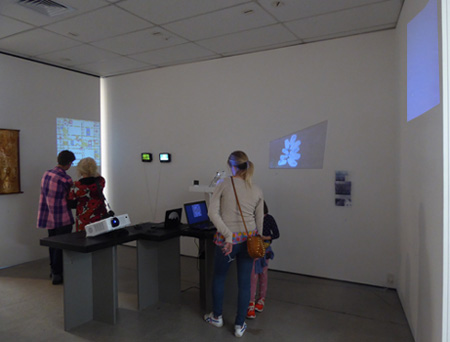
“Outer Mantle 3,” latex, LED lighting + recycled NZ pine, 2018, by Yair Callender. “Tomorrow will never be the same,” interactive projection by Jian Yiwei + Sonja van Kerkhoff. Two videos by Pietertje van Splunter. “A Meditation,” 7 min video loop by Sonja van Kerkhoff. “Several Seas,” laser print on transparency by Sonja van Kerkhoff. “The Experience of Change,” interactive projection by Jian Yiwei + Sonja van Kerkhoff.
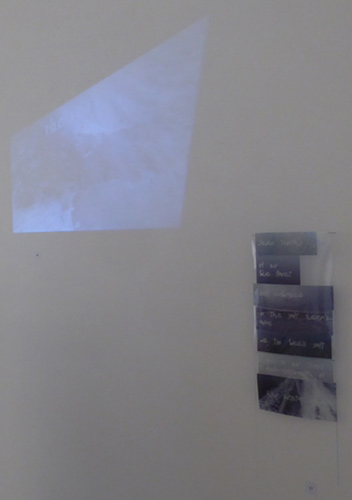
“Once our World had Edges” 2017, 3 min, 22 sec., HD video using only NASA International Space Station footage. Music: ‘a distant backdrop’ by sink \ sink, on the album ‘a lone cloudburst’ by Gareth Schott.
“Several Seas,” laser print, edition of 50, by Sonja van Kerkhoff.
Met dank aan Stroom Den Haag / with thanks to STROOM The Hague for finanicial assistance as well as to NorthArt.
Enter your email address to subscribe to this blog and receive notifications of new posts by email.
